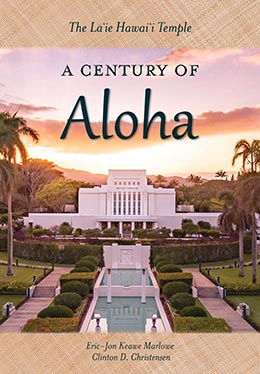The War Years—1940s
Eric-Jon Keawe Marlowe and Clinton D. Christensen, "The War Years—1940s," in The Lā'ie Hawai'i Temple: A Century of Aloha (Religious Studies Center, Brigham Young University; Salt Lake City: Deseret Book, 2019), 233–254.
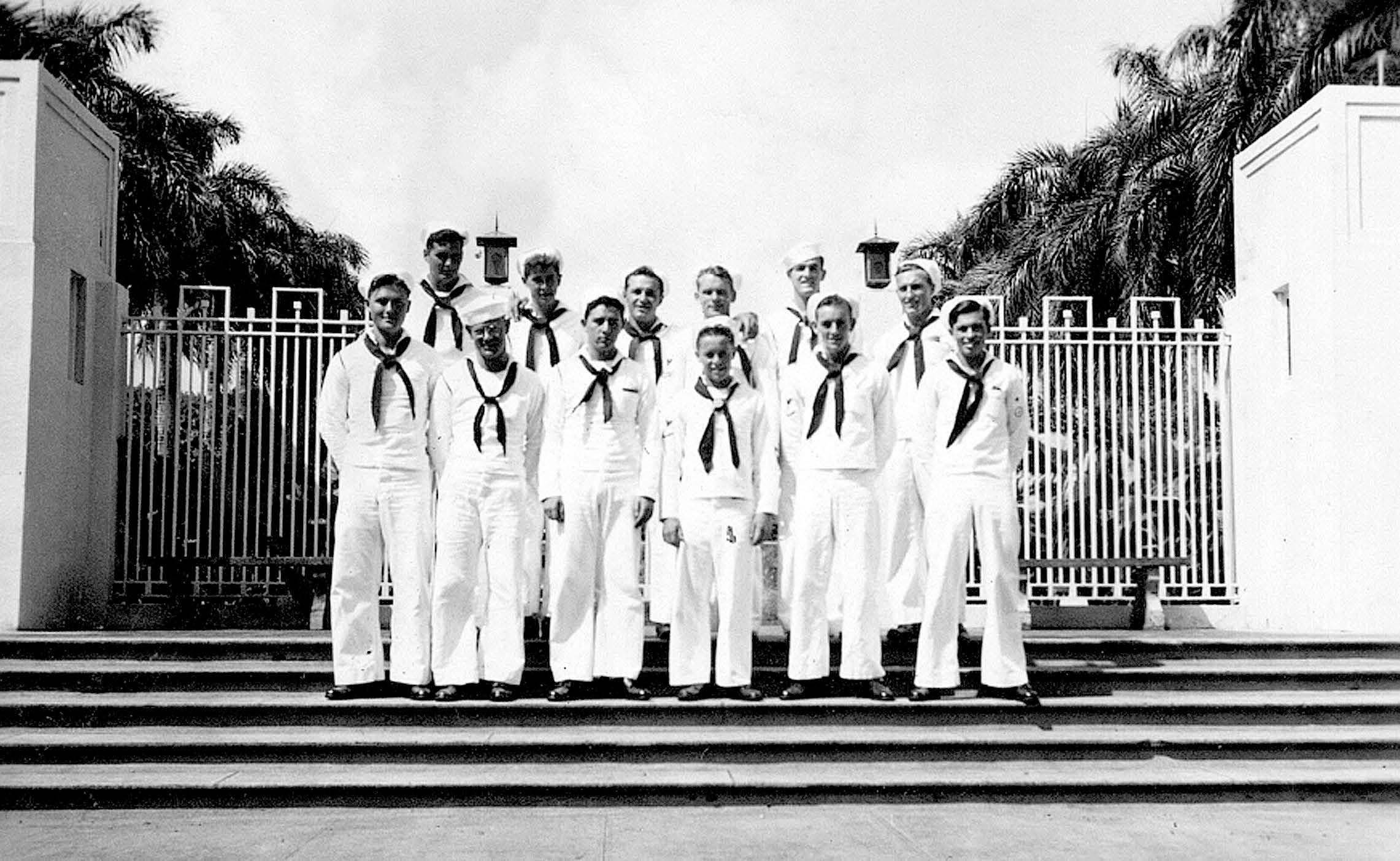 Top: During World War II thousands of servicemen visited the temple grounds. These photos of crew members of the battleship North Carolina were likely taken in 1942 after their ship was struck by a torpedo and then docked in Hawai‘i for repairs. Bottom: Crew member John Stewart poses in front of the temple. Photos courtesy of battleship North Carolina, used by permission.
Top: During World War II thousands of servicemen visited the temple grounds. These photos of crew members of the battleship North Carolina were likely taken in 1942 after their ship was struck by a torpedo and then docked in Hawai‘i for repairs. Bottom: Crew member John Stewart poses in front of the temple. Photos courtesy of battleship North Carolina, used by permission.
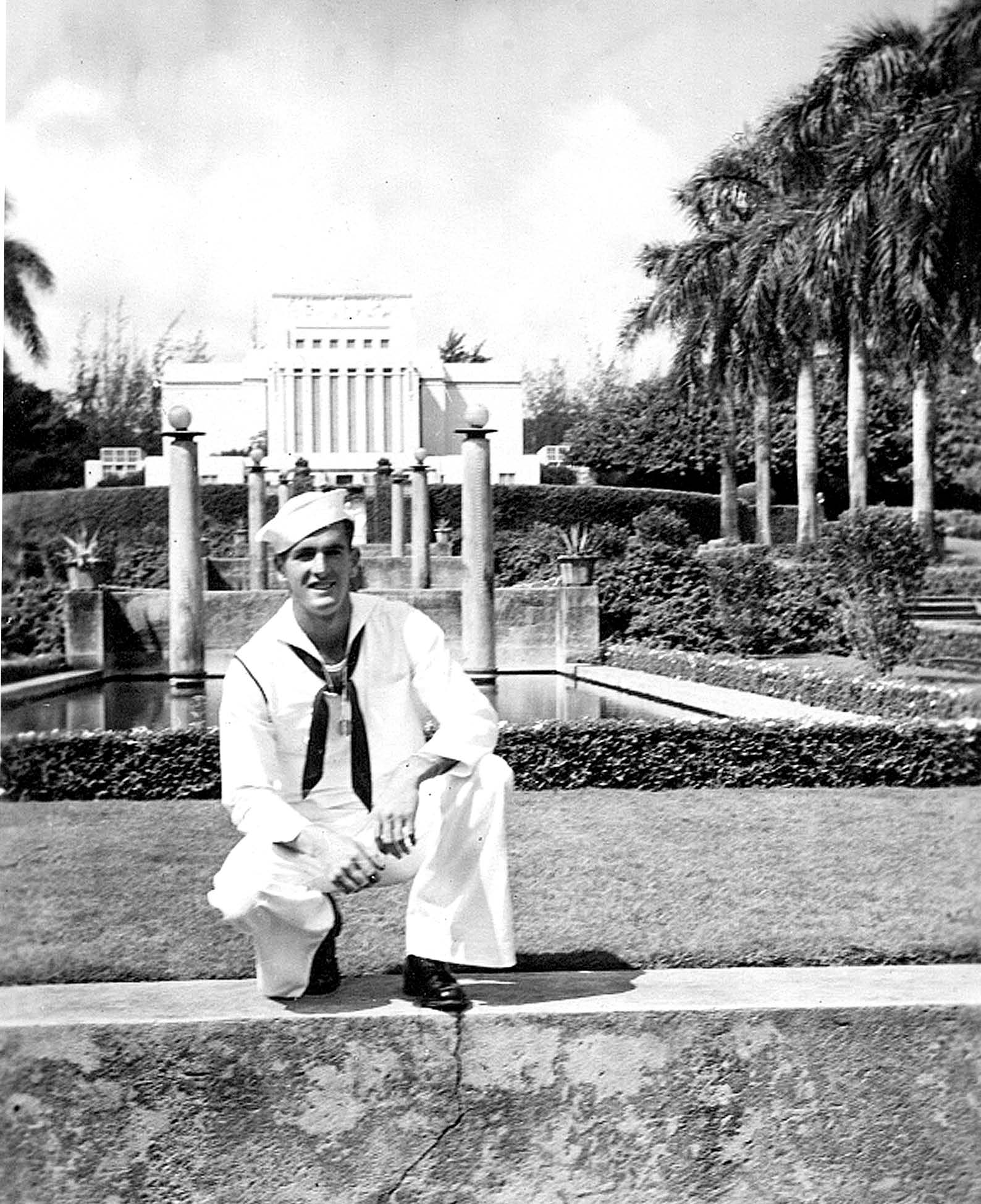
Germany invaded Poland in September 1939, and France and Great Britain, honoring their treaty with Poland, entered the war against Germany. However, the United States declared its neutrality, and Hawaiʻi, half a world away, seemed unfazed by the European conflict.
Yet the Asia/
Albert and Elsie Belliston
Amid these global conditions, in March 1941 President David O. McKay, then Second Counselor to President Grant, called Albert Henry Belliston and his wife Elsie Elizabeth as president and matron of the Hawaii Temple. The following month, Albert was set apart and given the sealing authority by President Heber J. Grant, and President McKay set Elsie apart as temple matron. Then, aside from a few brief instructions, the Brethren bid them “good wishes” as the Bellistons set out for Hawaiʻi with their nine-year-old son Angus.[2]
As the Bellistons assumed temple responsibility from the Murphys in May 1941, the state of the Church in Hawaiʻi appeared solid. It included a stake (the first outside North America), two missions within its borders (Hawaiian and Japanese), and approximately fifteen thousand members. Further, temple attendance had increased as years of economic depression gave way to more prosperity, owing in part to the US military buildup in the islands. Yet tensions with Japan remained, and in response to Japan’s expanding occupation, that summer the United States froze Japanese assets and established an oil and gasoline embargo on Japan.
Weeks later, in August 1941, President McKay visited Hawaiʻi to attend the Oʻahu Stake conference and dedication of the new stake tabernacle in Honolulu. During his stay President McKay attended the temple and complimented the Hawaiian members on how well they handled the ceremonies.[3] President McKay also took this opportunity to suggest that President Belliston call counselors. Accordingly, Edward L. Clissold and William M. Waddoups (Albert’s old missionary companion, recently returned to Hawaiʻi) were set apart by President McKay before he left.[4] As both these men already had the sealing authority, President McKay said permission to perform the ordinances could be given in a letter from President Grant.[5]
Pearl Harbor
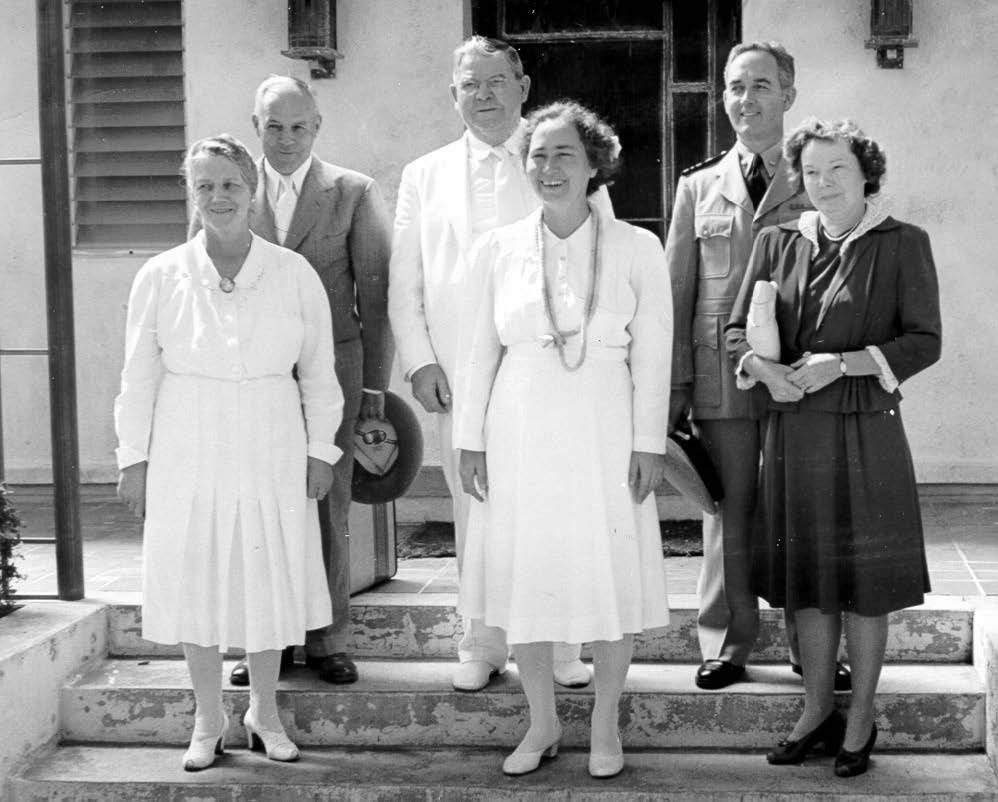 In August 1941 temple president Albert H. Belliston (center, back row) was authorized to call counselors to assist him, William M. Waddoups (left) and Edward L. Clissold (right), shown here with their wives. Calling counselors became standard practice for all Hawaii Temple presidents thereafter. Courtesy of BYU–Hawaii Archives.
In August 1941 temple president Albert H. Belliston (center, back row) was authorized to call counselors to assist him, William M. Waddoups (left) and Edward L. Clissold (right), shown here with their wives. Calling counselors became standard practice for all Hawaii Temple presidents thereafter. Courtesy of BYU–Hawaii Archives.
“War with Japan was threatening,” recalled Angus Belliston, “but everyone hoped and expected it could be avoided. No one was prepared when it happened. And especially, no one was prepared for how it happened.”[6]
While in Honolulu mailing Christmas gifts to family three days before the attack, Sister Belliston was taken aback by the number of soldiers that she described as “a sea of moving white [clothed] men.” She wrote, “The fleet was in, the sidewalks were crowded, and men were spilling over into the street.” She then described her return to the “peaceful” temple town of Lāʻie, where after a relaxing Saturday they settled in “to a quiet sleep.”[7]
The Bellistons arose Sunday morning, 7 December 1941, to their usual routine of overseeing the temple Visitors’ Bureau, while Grant and Connie Sorensen (temple-assigned missionaries) attended the Japanese Sunday School, after which the Sorensens would cover the Visitors’ Bureau while the Bellistons attended the Hawaiian Sunday School that followed. Somewhat unusual, there were no visitors to the Bureau that morning. The Sorensens came from Sunday School anxious about rumors of an attack on Pearl Harbor (only twenty nautical miles away). These rumors persisted until, “finally, in Fast Meeting, former Bishop Plunkett [temple recorder] stood and said he had gone home between meetings and heard on the radio that Pearl Harbor had indeed been bombed, and Japan had declared war on the United States.” Sister Belliston noted that the tone of the meeting changed and that “everyone who spoke talked of the need for goodness and loyalty and faith.” Then she added, “It was hard to adjust our thinking to war and strife and killing.”[8]
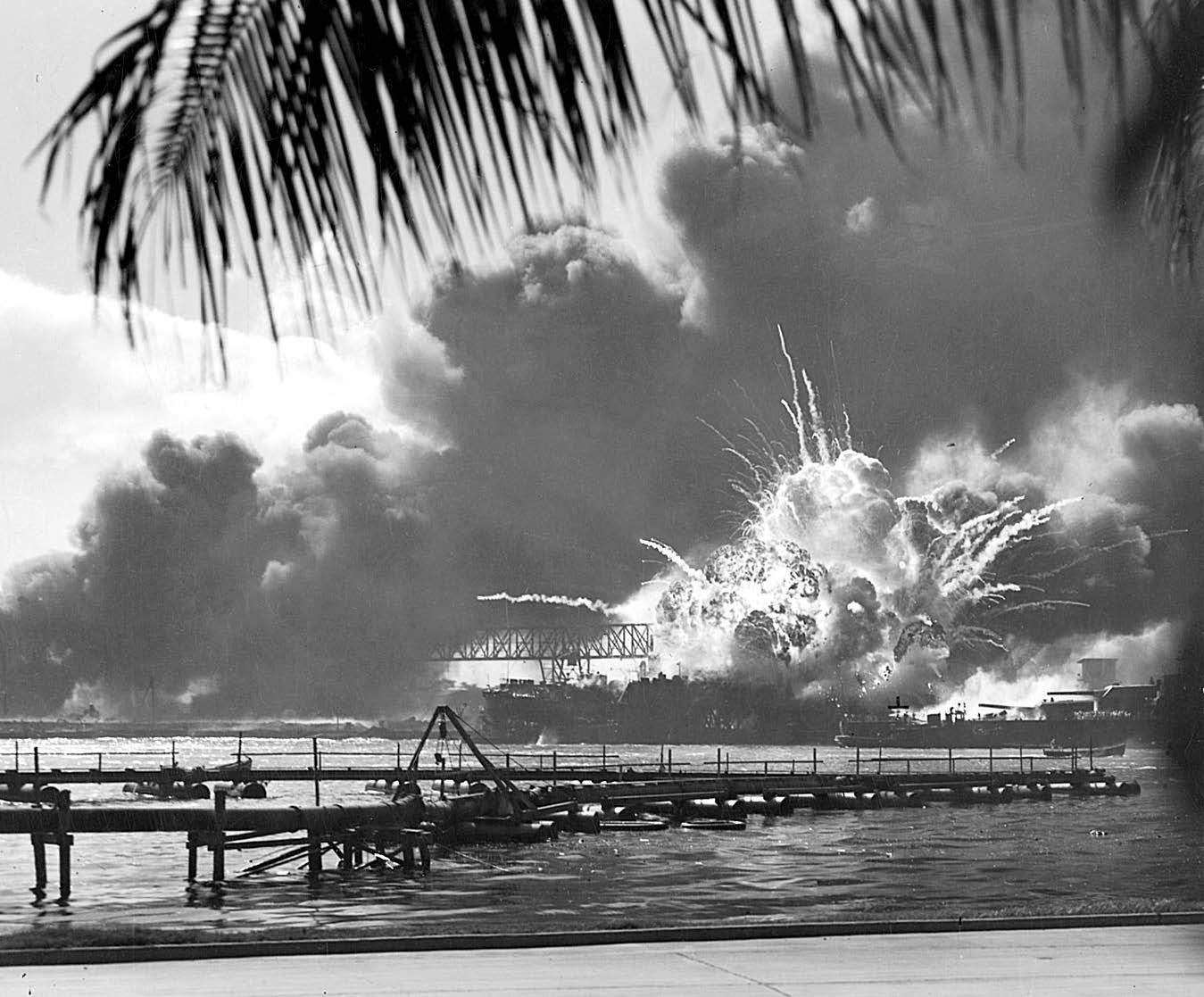 Only twenty nautical miles from the temple, the attack on Pearl Harbor drastically altered life in Hawai‘i. Six weeks later, amid minimal normalcy, Church meetings resumed, along with reduced temple sessions. Courtesy of Wikimedia Commons.
Only twenty nautical miles from the temple, the attack on Pearl Harbor drastically altered life in Hawai‘i. Six weeks later, amid minimal normalcy, Church meetings resumed, along with reduced temple sessions. Courtesy of Wikimedia Commons.
After the meeting the Bellistons hurried back to the Visitors’ Bureau. There still had been no visitors; however, they noticed a car parked near the temple. The family therein had witnessed the bombing that morning, and in haste (the mother and daughters still in their nightgowns) had driven to the “Mormon temple, feeling that was the place they might find divine protection.” Sister Belliston offered her hospitality and assured them they could stay as long as they liked.[9]
In addition to Pearl Harbor, the Japanese also struck Guam, Wake Island, the Philippines, Malaya, and Hong Kong. These other strikes were followed by invading troops, and many assumed this would happen in Hawaiʻi as well. That afternoon, Scoutmaster Lionel Broad[10] got his Scouts together to review first-aid training. He then asked them to stand guard in the temple community throughout the night—four hours on, then four hours off. This duty continued for several nights until the military could get fully organized.[11]
Later, Sono Koizumi, a Buddhist neighbor of the Bellistons, came with her children to the temple president’s home. They were terrified and seeking protection after Sono’s husband Gensaku had been taken into custody, and she feared she would never see him again.[12] By 1940, Japanese made up Hawaiʻi’s largest ethnic population with 37 percent, and three-fourths of them were Nisei—second-generation Japanese who had been born in Hawaiʻi. The Bellistons and Koizumis had become close friends, and sympathetic to the Koizumis’ fear and confusion, the Bellistons took them in.[13] The Koizumis’ son Kotaro was good friends with the Bellistons’ son Angus. (Kotaro later joined the Church, and years later both he and Angus served as mission presidents in Japan and Australia, respectively.)[14]
Finally, there are accounts that the temple was protected from damage or destruction following the attack on Pearl Harbor. According to these accounts, a Japanese pilot saw the unidentified white building in the middle of sugarcane fields as a target of opportunity for jettisoning an unused bomb while returning to his aircraft carrier about three hundred miles north of the island of Oʻahu. After failing in an attempt to release the bomb or strafe the temple, the frustrated pilot left the area and succeeded in releasing the bomb into the ocean before returning to his fleet.[15]
Post–Pearl Harbor
The next day the United States declared war on Japan, and three days later Germany and Italy declared war on the United States. Every resident of Hawaiʻi was affected by the war. Within hours of the attack on Pearl Harbor, martial law was declared in Hawaiʻi and blackouts, rationing of gasoline, and restrictions on communications and movement such as curfews followed. The temple was closed, and Church meetings were discontinued indefinitely. In a military-allotted radio message a week after the attack, Hawaii Mission president Roscoe C. Cox stated, “Until the time comes when we may resume our regular meetings and services, the members are urged to remember their prayers and keep their devotions in their homes.” He further admonished members to “always show your loyalty to this nation and your faith . . . by living your religion. Do not have hate in your hearts for any nation or any people, no matter how you may dislike systems of government which would destroy your cherished freedoms, including the freedom of worship.”[16]
Concern of an invasion was palpable.[17] Japan hoped to “smash what was left of the Pacific fleet, take Hawaiʻi, hold its people hostage and force the United States to sue for peace.”[18] Amid such uncertainty, President Belliston worried about the security of temple records and arranged to have them microfilmed. Barely three weeks after the Pearl Harbor bombing, and in a span of just seven days, all the records from the dedication of the temple in 1919 through 1941—10,446 pages in all—were duplicated on microfilm.[19] Moreover, before the full-time missionaries were withdrawn, two elders were granted permission to microfilm hundreds of the territory’s most valuable historical documents, including the Bishop Museum’s collection and the probate records of the Hawaiian Supreme Court. It was later written, “These precious rolls of film, now on file in Salt Lake City, give us an unequaled source of Genealogical research and guarantee the preservation of these priceless records for all time.”[20]
Six weeks after Pearl Harbor was bombed, amid minimal normalcy, Church meetings in Hawaiʻi resumed, and it was announced that the temple would be open for one session a week on Saturday mornings. Those sessions, wrote Sister Belliston, “were always highlights of our week.”[21] And in addition to the scheduled Saturday morning session, the temple presidency eagerly sought to accommodate Latter-day Saint soldiers’ requests to attend the temple whenever it was possible.[22] Sister Belliston recalled:
One day in January, President Waldron, the new mission president phoned on behalf of a young soldier and his wife who desperately wanted to receive their endowment and be sealed in the temple before he went off to the battlefront and she was evacuated home. She was pregnant and was so anxious for her baby to be born in the [covenant]. She had joined the Church less than a year before and was not technically eligible for her endowment. But . . . an exception was made by the temple president. We organized enough temple workers to hold a session. At our prayer meeting the Spirit was so strong we were all melted to tears. Sister Kelii could hardly perform her part in the ceremonies. When the wonderful sealing was performed by the temple president it was enough to repay everyone for the little effort that had been required.[23]
Managing the temple during the war years presented multiple challenges. Sister Belliston noted, “It was very difficult to find sufficient workers to staff the sessions.”[24] Need for civilian workers in the war effort was high, and many members, including temple workers, accepted defense jobs that generally required residing in the Honolulu area. Then, because of the rationing of gas, most members were simply unable to make the trip to the temple in Lāʻie.[25] However, “little miracles always seemed to make it possible to cover all the necessary parts of the ceremony.”[26]
All temple activity was conducted during the daytime until the blackout restrictions were lifted in May 1944. Sister Belliston explained that another part of the new normal during the war years was the “disruption of our peaceful temple sessions . . . [by] frequent noisy warplane activity which accompanied their bombing and strafing practice on the rocks of Laie Bay.”[27] When this occurred during temple ceremonies, the patrons simply paused, and when the noise ended, “the peace of the temple returned, leaving everyone thinking of the blessing of peace they all enjoyed in the midst of the strife.”[28]
With so many community members now working in the war effort, pragmatically President Belliston himself maintained the temple and its grounds, and he was particularly appreciative of two Japanese men he hired to assist him. Sister Belliston took on the roles of temple laundress and seamstress, and their son Angus, then only ten years old, “often acted as a guard and guide on the grounds to help control [visitor] noise from coming through the open windows into the temple, and to assist any visitors who might come.”[29]
Adding to these challenges, there was a shortage of names for temple work. President Belliston wrote to the First Presidency about this shortage and other challenges caused by the war, but reassurance and encouragement were largely all Church leadership in Utah could offer.[30] Though temple sessions were few and sometimes sporadic, the Bellistons, with assistance from the Clissolds, Waddoupses, and other faithful Saints, pressed forward.
Servicemen Visiting the Temple Grounds
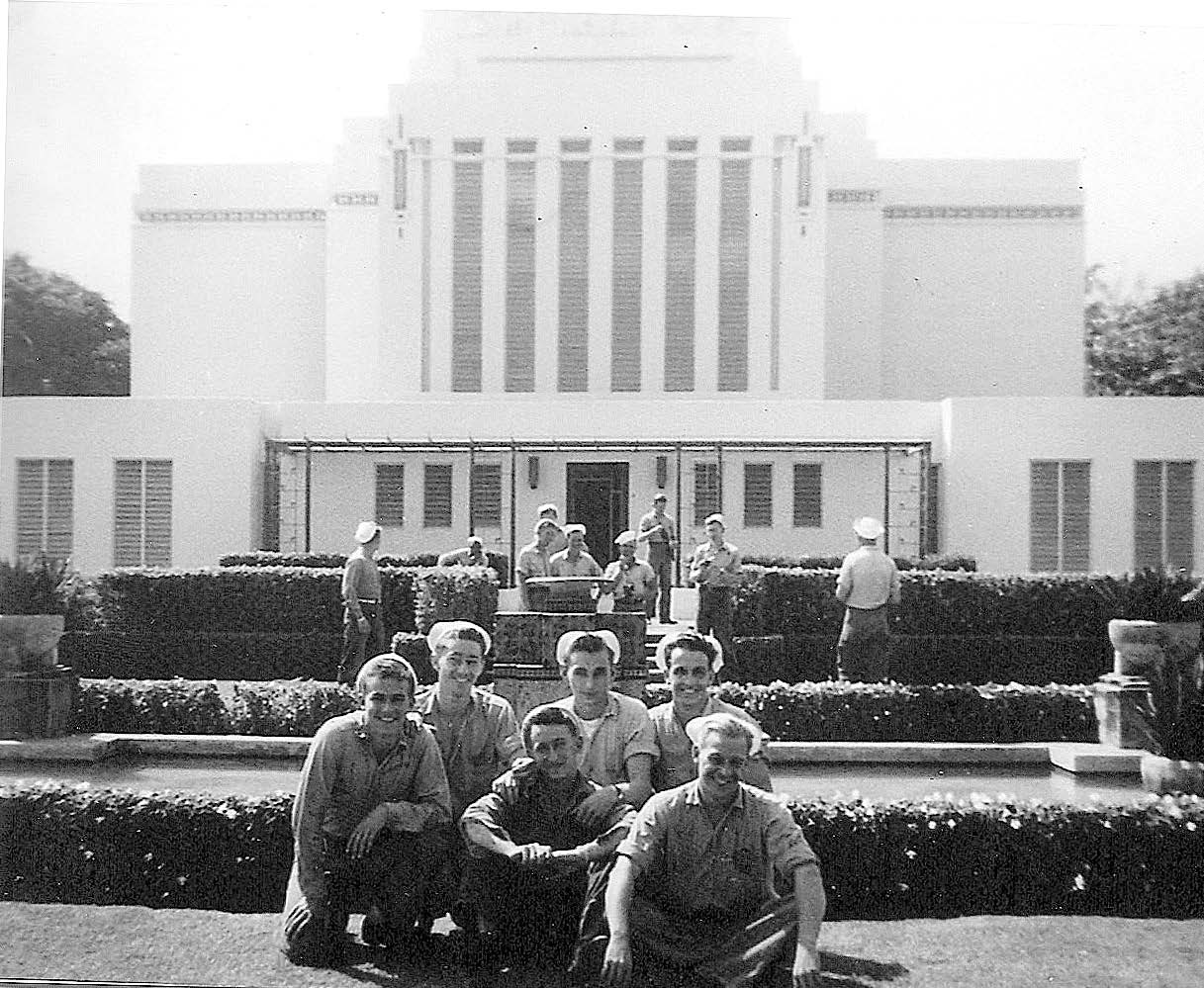
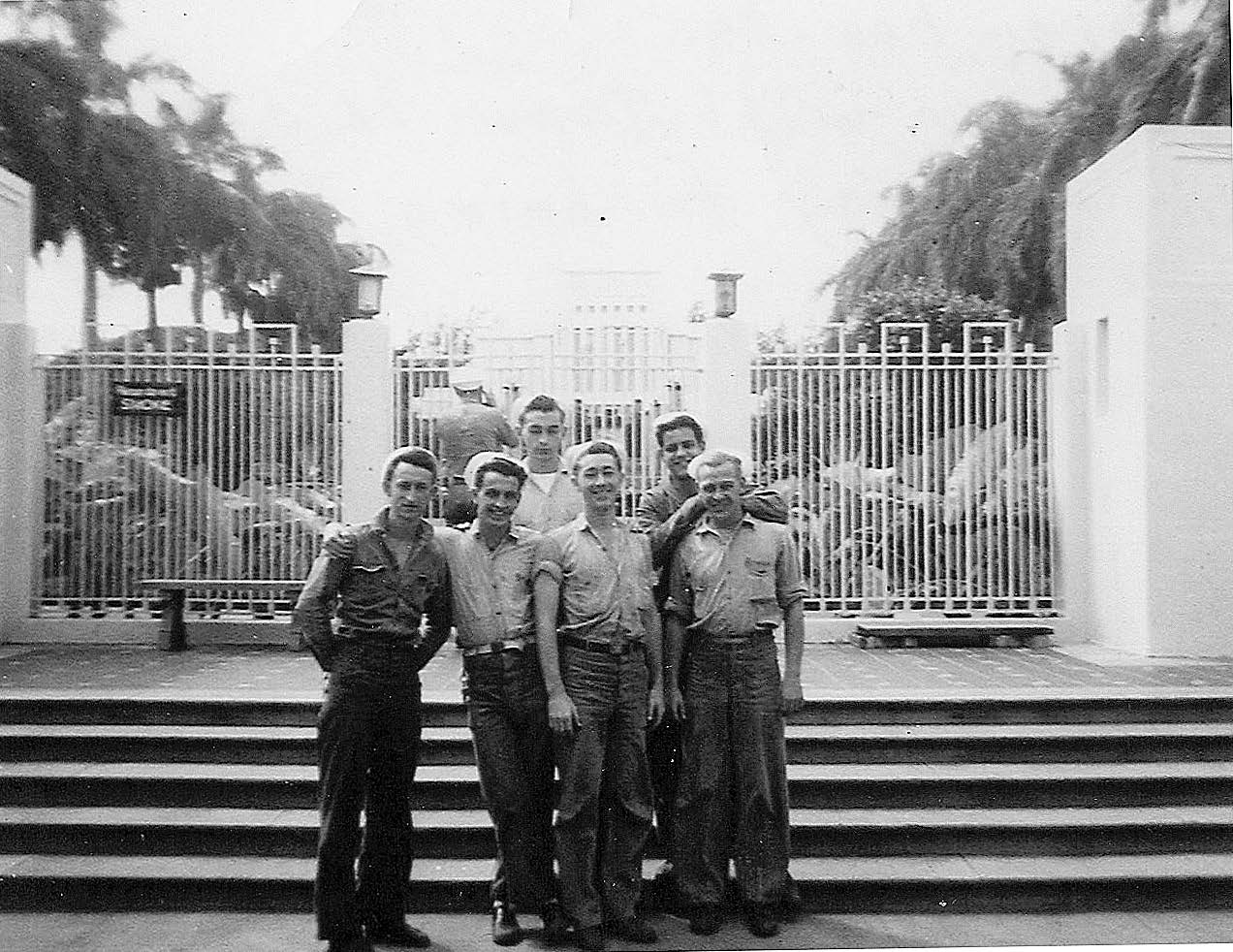 Convoys of trucks took World War II soldiers to places of interest in Oʻahu. These convoys would come to the temple and unload upwards of five hundred at a time. Photos courtesy of BYU–Hawaii Archives.
Convoys of trucks took World War II soldiers to places of interest in Oʻahu. These convoys would come to the temple and unload upwards of five hundred at a time. Photos courtesy of BYU–Hawaii Archives.
During the war, thousands of servicemen found themselves unexpectedly in Hawaiʻi while en route to and from the Pacific war zone. Military commanders, mindful to combat the boredom of their troops, arranged convoys of trucks to take the soldiers to places of interest on Oʻahu. These convoys would come to the temple and unload upwards of five hundred at a time. Every member available was pressed into duty, including young Angus. Attention in these tours was drawn to the friezes adorning the top border of the temple and reproduced inside the Visitors’ Bureau. The missionaries and member volunteers who guided these tours considered the sculpted depictions on these reliefs “a great introduction to the history of the Church in the world and the Plan of Salvation.”[31]
Many among these large numbers of servicemen, far from home and facing a worrisome future, felt the “sweet and peaceful influence” of the temple grounds, as President Heber J. Grant foretold they would in the temple’s dedicatory prayer. Angus later wrote of these soldiers, “Some were members of the Church; most were not. But almost all who expressed themselves were grateful they were able to come to such a place.”[32]
Occasionally, when servicemen visiting the temple were unable to reach their bases before the mandatory blackouts, the local members would open up their homes to them.[33] Angus Belliston recalled that almost every evening on the lawn in front of Lanihuli house near the temple there were “Hawaiian, Samoan and Japanese kids, along with two or three soldiers playing volleyball.”[34] It seems almost metaphoric of its role as a beacon of peace and refuge that at the height of World War II Japanese children and American soldiers could affably play volleyball together near the temple.[35]
Molokaʻi Saints’ Temple Trip, 1942
The Molokaʻi Saints had returned from their ninth annual Thanksgiving temple trip just days before Pearl Harbor was attacked. And likely no one, aside from the Molokaʻi Saints themselves, even considered they would attempt their tenth annual trip under the strident conditions of war in 1942. Yet the Molokaʻi Saints sent a delegate to Oʻahu to obtain mission approval for the excursion and to make arrangements if possible.
Notwithstanding the army’s rigid restriction on inter-island transportation, a special plane was made available to them by the president of Inter-Island Airways (now Hawaiian Airlines). Though a generous accommodation, it was still three times the cost of travel by boat. The Lāʻie welfare farm furnished most of their food, and since the army had commandeered the Lanihuli house where these Saints normally stayed while attending the temple, arrangements were made for them to be housed with community members. Moreover, just enough temple workers for the additional sessions were able to obtain leave from their war work.
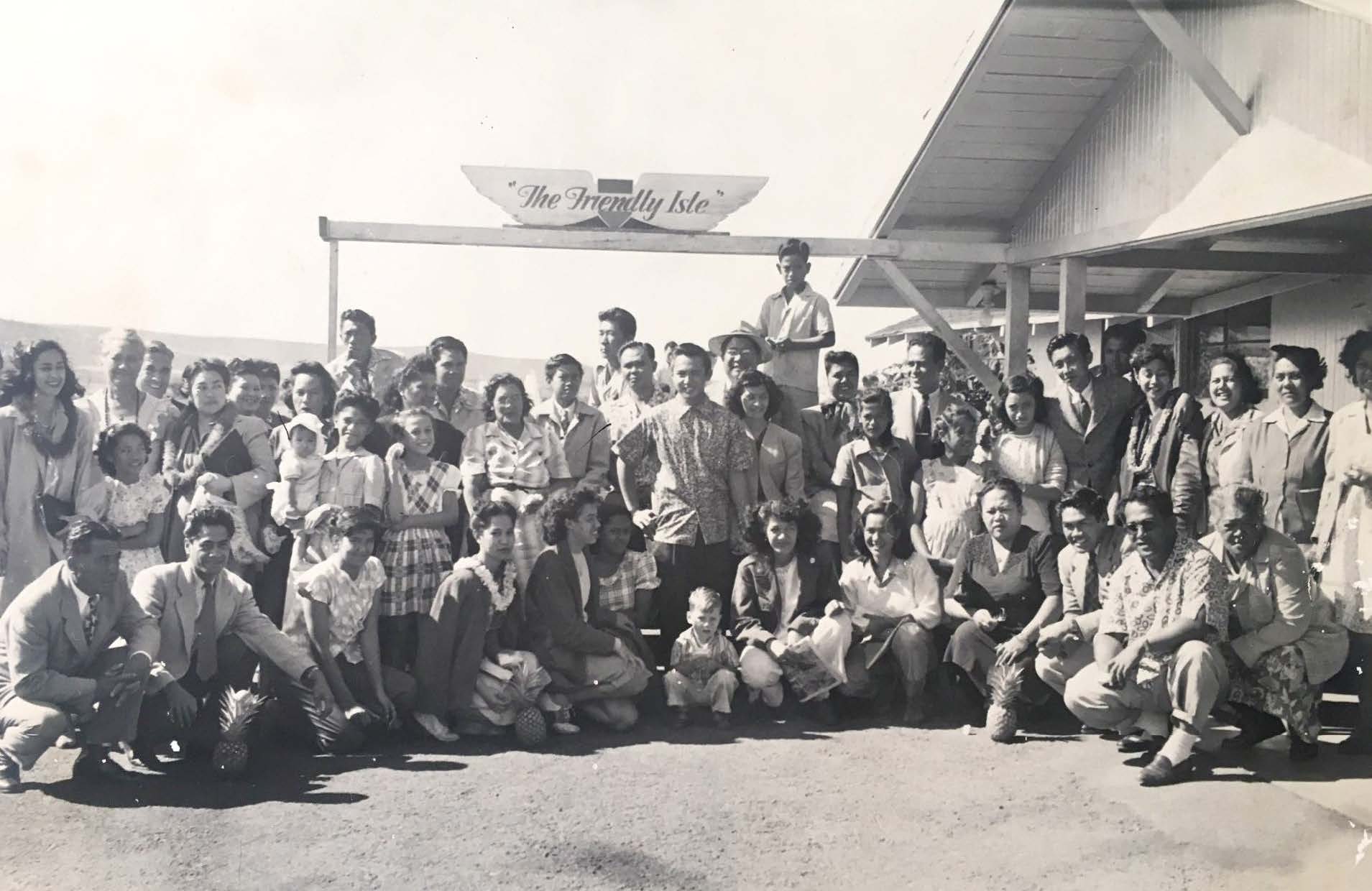 Moloka‘i Saints at the airport in the 1940s. Despite many obstacles during World War II, these Saints continued their tradition of an annual temple trip, inspiring others to do the same. Courtesy of Church History Library.
Moloka‘i Saints at the airport in the 1940s. Despite many obstacles during World War II, these Saints continued their tradition of an annual temple trip, inspiring others to do the same. Courtesy of Church History Library.
The excursion numbered thirty-five Saints, and five temple sessions were held over a period of four days—easily the most work done in the Hawaii Temple during any four-day span in 1942. In a show of appreciation, the Molokaʻi temple group gave service—the women worked in the temple laundry washing and pressing clothes while the men planted potatoes and did other work on the welfare farm at Lāʻie.[36]
In a letter to the First Presidency describing the Molokaʻi Saints’ temple excursion, President Waldron concluded, “As I stood at the airport and watched the plane filled with saints take off and disappear into a heavy rain storm I was moved by their dauntless spirit. Perhaps nowhere in the islands is there a more faithful or courageous group of people.”[37] The Molokaʻi Saints’ effort to attend the temple in 1942 offered an inspirational example that Church members from other islands would follow.
Apart from the Molokaʻi excursion, temple work in the year following the Pearl Harbor attack was very slow, generally (though not always) limited to one session a week. Thus in early 1943, with war still raging and no early end in sight, the First Presidency did not feel a full-time temple president was needed, and Albert and Elsie Belliston were honorably released.[38] It is worth noting that almost fifteen years later when asked to share something about their experience presiding over the temple, the Bellistons succinctly wrote: “Those were dark days. It was remarkable what a comfort it was to us all to have a House of the Lord in our midst. No harm came to Laie or the Temple.”[39]
The Clissolds Are Called Again
With the Bellistons’ release, a letter dated 4 February 1943 was sent to Edward L. Clissold from the First Presidency (Heber J. Grant, J. Reuben Clark, David O. McKay): “Although you are already heavily overburdened, yet we feel impressed to place upon you, at least for the time being, the responsibility of President of the Temple.”[40] Still serving as first counselor in a stake presidency and on active duty with the Navy, Clissold felt fortunate that his naval assignment allowed him to go to Lāʻie once a week to hold a temple session.[41] “This is no great additional burden,” he wrote in his journal, “and I am happy as always to serve in any capacity in the House of the Lord.”[42]
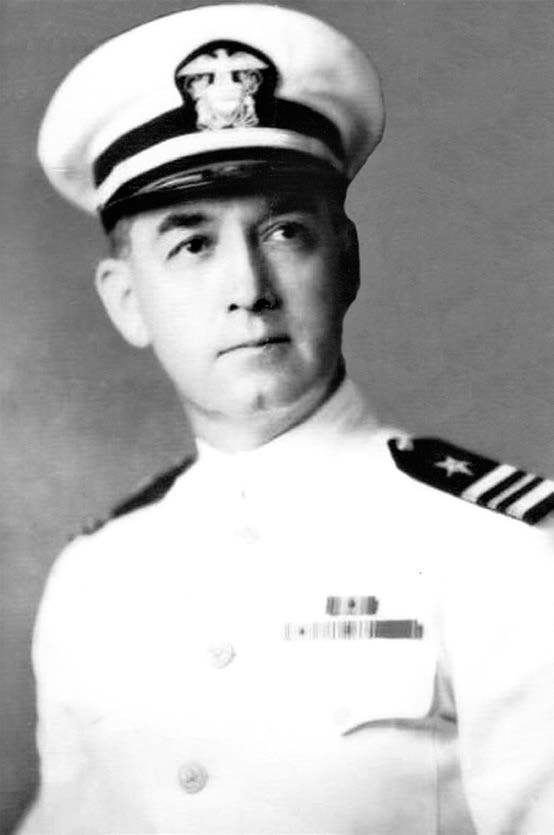 During the war years Edward L. Clissold was again called to serve as Hawaii Temple president. On active duty with the Navy, he felt fortunate that his assignment allowed him to go to Lāʻie at least once a week to hold temple sessions. Courtesy of BYU–Hawaii Archives.
During the war years Edward L. Clissold was again called to serve as Hawaii Temple president. On active duty with the Navy, he felt fortunate that his assignment allowed him to go to Lāʻie at least once a week to hold temple sessions. Courtesy of BYU–Hawaii Archives.
Occasionally, as noted earlier, there would be a request from a group of soldiers for a temple session, to which President Clissold would invite temple workers and members specifically to accommodate these requests,[43] and from time to time there were marriages.[44] Generally, though, filling a temple session even once a week was a challenge. President Clissold later wrote that “some consideration was given at this time to the possibility of closing the Temple because of the difficulty of holding sessions during the blackout and the transportation problem raised by the rationing of gasoline. The Temple, however, was such a source of strength to the local people, as well as the servicemen passing through Hawaii to and from the battlefronts in the Pacific, that it was decided to have at least one session a week, regardless of the number attending.”[45]
“These sessions held during the war, each attended by some servicemen, were highly spiritual occasions,” wrote President Clissold. “In the meetings before the sessions, the men returning from the front bore testimony of the protection received through the observance of their covenants and those going to the front expressed confidence in the ultimate purposes of the Lord.”[46] He later added, “These men came with great hunger for rejuvenation of their own spirits, coming out of war situations that were traumatic. So that coming to the temple, they brought a great spirit of humility and eagerness to worship.”[47] President Clissold, on active duty himself, found great comfort in these sessions. “Being in the midst of war activities during the week and being particularly cognizant of the activities in the Pacific through my [naval] position,”[48] he wrote, “I found within the quiet and hallowed walls of the Temple, relief from worry aroused by the changing fortunes of our forces at the front.”[49]
Hawaii Mission President Eldred L. Waldron
In January 1942, one month after the Pearl Harbor attack, Eldred L. Waldron, barely thirty-two years old, was called to replace the outgoing Hawaii Mission president. Almost immediately, President Waldron set out to personally visit Church members throughout the mission. Upon returning, Waldron called a special conference of all district presidents and mission supervisors and shared an inspired list of priorities to maintain members’ vitality during the war. Among those priorities was a focus on genealogy and temple work.[50]
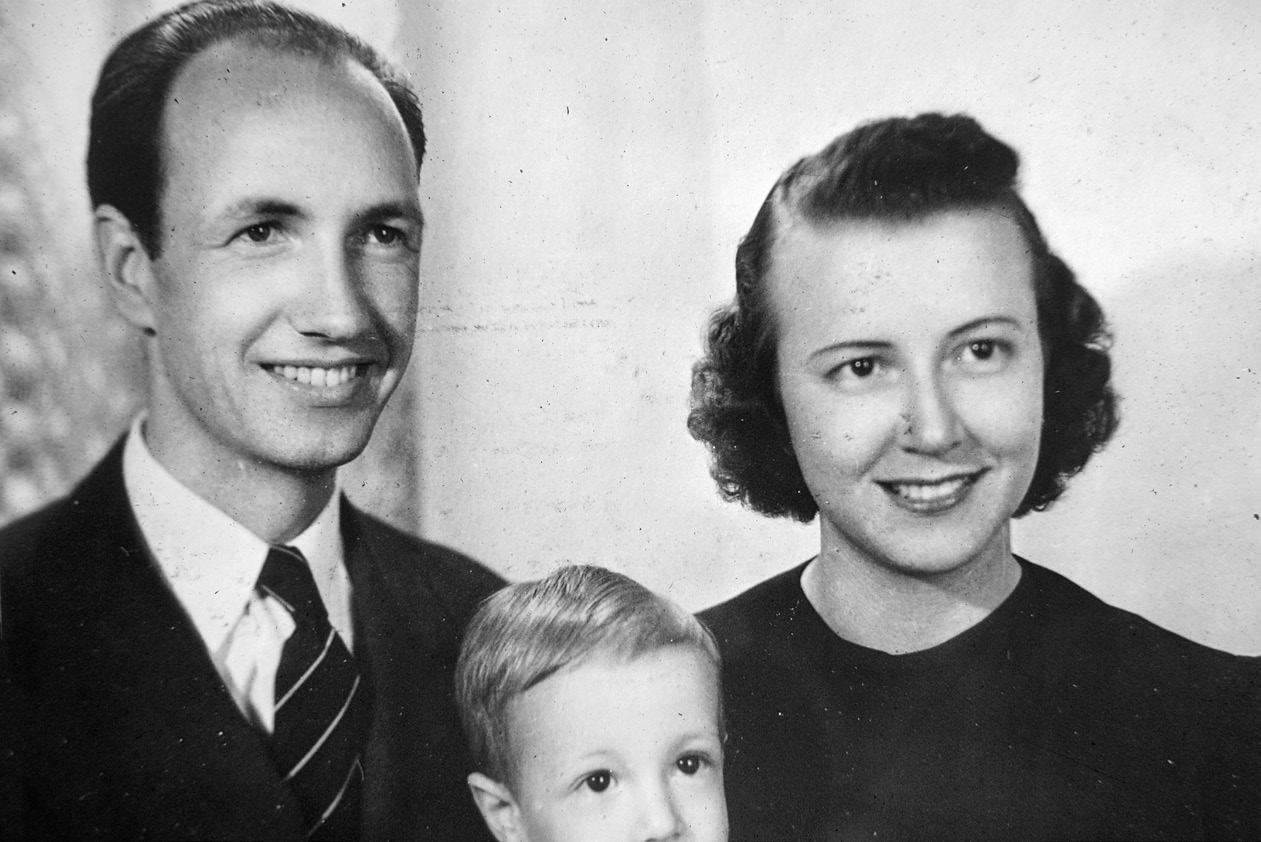 Mission president Eldred Waldron with wife Inez and son John in 1942. During the war, Waldron created “Temple Goers clubs" with the goal of organizing outer-island excursions, and he maintained fifteen genealogical organizations. Courtesy of John Waldron.
Mission president Eldred Waldron with wife Inez and son John in 1942. During the war, Waldron created “Temple Goers clubs" with the goal of organizing outer-island excursions, and he maintained fifteen genealogical organizations. Courtesy of John Waldron.
With early war restrictions making travel to the temple nearly impossible, mission leaders instituted a “special meeting for temple goers . . . and stirred to remembrance their covenants.”[51] Then, inspired by the success of the Molokaʻi temple trip in November 1942, the mission created “Temple Goers club[s]” with the goal of organizing outer-island excursions to the Hawaii Temple.[52] Despite the formidable conditions of the war, in his end-of-year report for 1943 President Waldron recorded:
An outstanding accomplishment this year was the completion of an excursion to the Hawaiian Temple from each of the four islands [Kauaʻi, Molokaʻi, Maui, Hawaiʻi]. This is the first time excursions have come in from all the islands in one year. Thousands of ordinances for the dead were performed: also numerous sealings, marriages and endowments. Present war conditions made it necessary for nearly all transportation to be made by airplane. These excursions have created considerable enthusiasm in temple work, and all islands are making plans for a similar excursion next year.[53]
In his 1943 report, President Waldron further included the function of fifteen genealogical organizations, and President Clissold noted improvement in the availability of temple workers.[54] And perhaps telling of the extremes during the war years, on 11 December 1943 President Clissold recorded: “Session at Laie today,—86—the largest in the history of the Temple.”[55] All these were encouraging signs of improvement. However, World War II persisted, and efforts to consistently hold even one temple session a week continued to experience the periodic disruptions of too few patrons, workers, and names for ordinance work.
Ralph and Romania Woolley
In May 1944, President Clissold and his wife Irene were released as temple president and matron owing to a military assignment on the mainland, and Oʻahu Stake president Ralph Woolley and his wife Romania were appointed in their stead.[56] Until President Woolley could arrange travel to Salt Lake City to receive the sealing authority, he asked previous temple president Castle Murphy, who had recently returned for another term of service as Hawaii Mission president, to perform any sealings and help oversee the temple during his absence.[57] President Woolley, who had recently retired from a successful construction business, would continue serving as Oʻahu Stake president. He held multiple civic and political positions throughout his career, was well regarded, and is likely the only builder of a temple who later became that temple’s president, a position he would hold for more than nine years (May 1944 to December 1953).[58]
Counselors in the Temple Presidency
In the Hawaii Temple’s first twenty-five years, temple presidents seldom had counselors. However, that would change under President Ralph Woolley and become the norm thereafter. Like previous temple presidents, Woolley initially relied on capable local members to help administer the temple services, not only in his absence but alongside him as well. However, not long into his tenure he submitted the names of two local men, Clinton J. Kanahele and Wallace G. Forsythe, to serve as his counselors. As far as is known, these two men became the first and second persons respectively of Polynesian descent (as well as the first non-Caucasians) to receive the sealing authority in this dispensation. From Kanahele’s call as a temple worker in 1927 to Forsythe’s conclusion as temple recorder in 1970, one or both of these men helped provide the steady service-leadership so essential to the temple’s success for more than four decades.
Recalling his wide-ranging duties, President Kanahele noted, “I do not know of any of the Temple work that I did not do and I thank God for all these opportunities to serve in His cause.”[59] And speaking of the years he and his wife spent serving in the temple, President Forsythe said, “We have both considered this responsibility the greatest that could come to us and have thoroughly enjoyed every minute that we have spent working in the House of the Lord.”[60]
War Ends
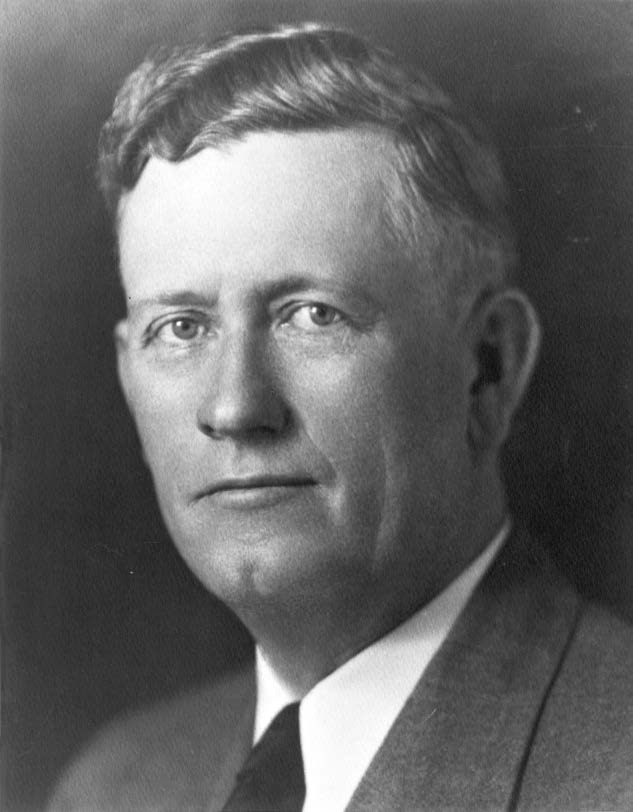 President Ralph E. Woolley is likely the only builder of a temple who later became that temple’s president, a position he would hold for more than nine years (May 1944 to December 1953). Courtesy of BYU–Hawaii Archives.
President Ralph E. Woolley is likely the only builder of a temple who later became that temple’s president, a position he would hold for more than nine years (May 1944 to December 1953). Courtesy of BYU–Hawaii Archives.
War with Japan officially ended on 2 September 1945, and later that month President Woolley recorded “a marked increase in [temple] ordinances performed” as a result of the “lifting of war restrictions and the release of gas.”[61] And by the end of the year he reported an “increase in all ordinances” over the previous year; then, looking ahead, he optimistically stated, “We are looking forward to an increased attendance and added sessions during 1946.”[62]
Another development at the close of the war was a deluge of visitors, mostly servicemen, to the temple grounds. From July through September 1945, President Woolley reported, “we conducted over 30,000 visitors through the grounds and distributed thousands of tracts.”[63] Among those thousands of visitors was the young soldier Boyd K. Packer (who later became an Apostle), who, while stationed on the island of Kauaʻi, was able to get a military transport to Oʻahu and then hitchhike to Lāʻie to visit the temple.[64]
Large numbers of soldiers returning from the war were being processed for discharge in Hawaiʻi, and thousands of them visited the temple grounds. To accommodate them, leaders created what was then called the “Temple Bureau Mission.” Several senior couples were called as missionaries for the purpose of escorting the visiting servicemen and answering their questions about the temple and Church. Rawsel W. Bradford and his wife Mary Waddoups Bradford (daughter of William and Olivia Waddoups) were called to preside. Rawsel had served a mission in Hawaiʻi, and Mary had mostly been raised there while her father presided over the temple—both knew and loved Hawaiʻi.[65]
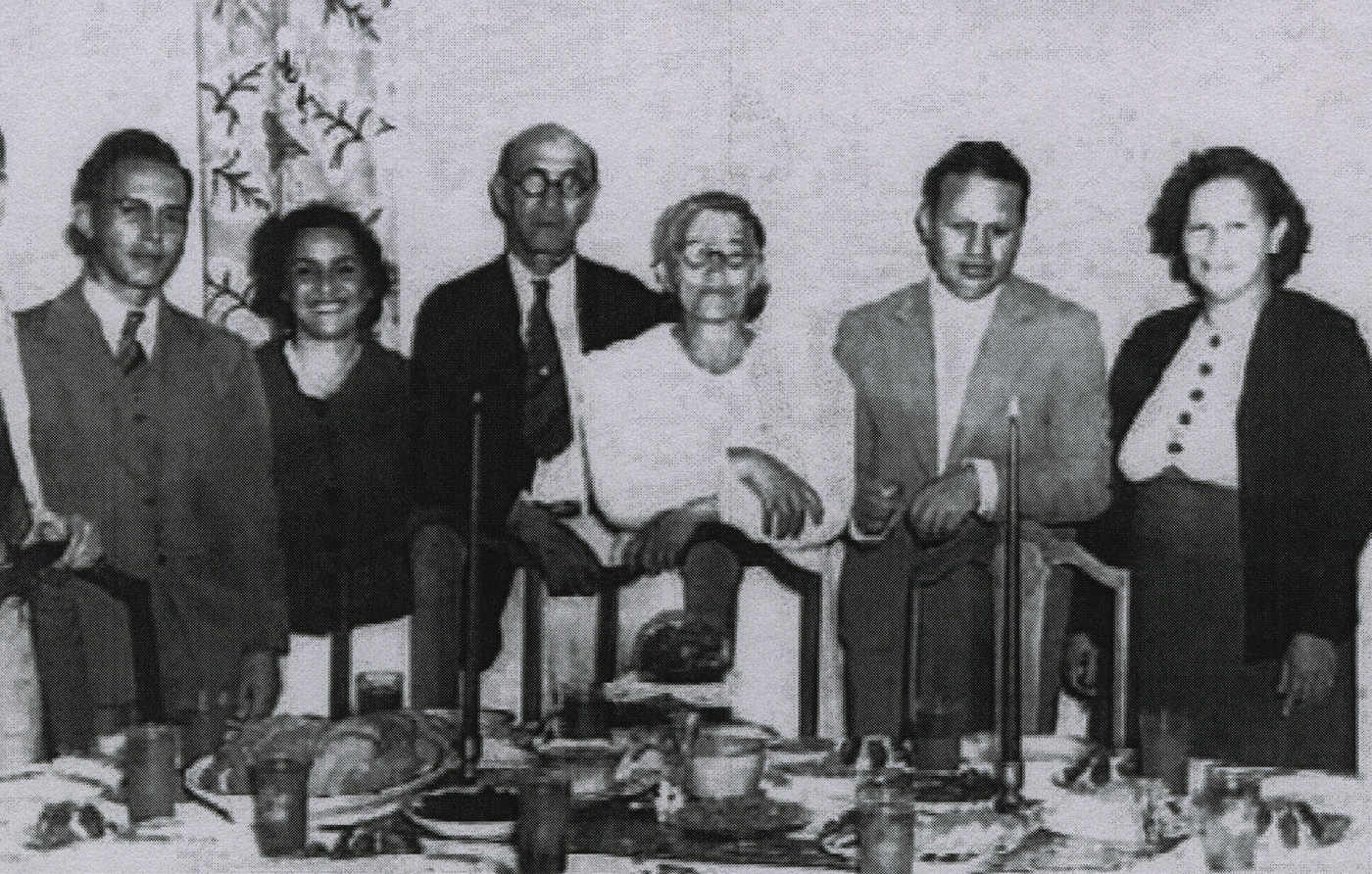 From left: Clinton and Mary Kanahele, Robert and Julia Plunkett, and Wallace and Hilda Forsythe. Combined, their administrative callings in the Hawaii Temple spanned more than fifty years. Courtesy of Wallace and Hilda Forsythe family.
From left: Clinton and Mary Kanahele, Robert and Julia Plunkett, and Wallace and Hilda Forsythe. Combined, their administrative callings in the Hawaii Temple spanned more than fifty years. Courtesy of Wallace and Hilda Forsythe family.
Addition to the Temple
As much as any other person, President Ralph E. Woolley had helped build the original temple, and during his nine-year tenure as its president he kept a keen eye on its upkeep. Perhaps the high-water mark of multiple temple improvements during this time was an addition to the temple annex in 1948.[66] Two extensions were made, one on the north and one on the south side of the annex, increasing the width to 140 feet.[67] Upon completion of the construction, President Woolley recorded that the additions “are very much appreciated by the workers and increase the efficiency of the work in the temple.”[68]
At the conclusion of President Woolley’s lengthy service, President Kanahele wrote that “all major additions and renovation to the temple since its dedication, which include the two front wings, louvers to windows, two wings at the bureau of information, glassed in approach to the front door of the temple, and improvements in the celestial and sealing rooms, have been constructed and effected under the direct supervision of President Woolley.”[69]
The conclusion of the 1940s saw a return to regularity of temple activity, yet with noticeable change. As expected, the large numbers of servicemen visiting the temple grounds diminished, and tourists began returning in growing numbers. However, a considerable contingency of military bases and personnel had become a permanent postwar presence in Hawaiʻi and have formed part of its fabric ever since. The annual outer-island temple trips supported by President Waldron during the war years would continue for years to come—the Maui Saints would come during Easter, the Kauaʻi and Big Island Saints would come in June, and the Molokaʻi Saints continued toward yet another decade of group temple trips during the week of Thanksgiving. Yet most remarkable in the years immediately following the war was that temple attendance approximately doubled year after year. President Forsythe, who later became the temple recorder, noted that by 1955 (ten years after the war’s end) the temple was doing more work in one month than had been done during the entire final year of the war.[70]
Notes
[1] See Honolulu Hawaii Mission Manuscript History and Historical Reports, Church History Library, Salt Lake City, UT (hereafter CHL; the mission history is hereafter cited as Honolulu Hawaii Mission History), 31 October 1940.
[2] Angus H. Belliston, Albert Henry Belliston, 1876–1965 (Provo, UT: A. H. Belliston, 1999), 115–16.
[3] See Belliston, Albert Henry Belliston, 119.
[4] See Belliston, Albert Henry Belliston, 118–19.
[5] Edward L. Clissold, journal, 21 August 1941, in private collection.
[6] Belliston, Albert Henry Belliston, 121.
[7] Belliston, Albert Henry Belliston, 121–22.
[8] Belliston, Albert Henry Belliston, 122–23.
[9] Belliston, Albert Henry Belliston, 123.
[10] Lionel Allen Broad was born on 13 August 1912, in Iosepa, Tooele County, Utah. His father, John Broad, and grandfather, Charles Broad, both helped build the temple.
[11] See Belliston, Albert Henry Belliston, 123.
[12] See Belliston, Albert Henry Belliston, 123.
[13] See Angus Belliston, “Talk Story,” Kaleo o Koʻolauloa, 11 February 2005.
[14] See Belliston, Kaleo o Koʻolauloa, 11 February 2005, which states, “Kotaro Koizumi, who was a Buddhist when we were kids, well the next time I saw him was at [LDS] General Conference [in Salt Lake City, Utah]: He was a bishop and I was a bishop. He had joined the church. We both went on to be stake presidents and mission presidents. We still have a close friendship” (see also “New Mission Presidents,” LDS Church News, 16 June 1973; and “New Mission Presidents,” LDS Church News, 1 April 1995).
[15] See Alf Pratte, “Not Quite ‘Purported’: Revisiting the Bombing Accounts of the Hawaii Temple, December 7th, 1941,” Mormon Pacific Historical Society (2005): 60–78. See also Riley M. Moffat, Fred E. Woods, and Jeffrey N. Walker, Gathering to Lāʻie (Lāʻie, HI: Jonathan Nāpela Center for Hawaiian and Pacific Islands Studies, Brigham Young University–Hawaii, 2011), 140; Kenneth W. Baldridge, “In Search of a Tale,” Mormon Pacific Historical Society (1988): 50–58; Lance Chase, Temple, Town, Tradition (Lāʻie, HI: Institute for Polynesian Studies, 2000), 99–112; and Mark Albright, “Is This Story True? Pearl Harbor Pilot Couldn’t Bomb Hawaii Temple,” LDS Living, 30 August 2015.
[16] Honolulu Hawaii Mission History, 14 December 1941. Message from mission president Roscoe C. Cox, broadcast on radio station KHBC.
[17] See Mark James, “World War Two in Hawaii: A Watershed,” Mormon Pacific Historical Society 24, no. 1 (2003): 44, https://
[18] See “The War, Timeline of World War II,” 4–7 June 1942, WETA, Washington, DC, and American Lives II Film Project, PBS.org, http://
[19] See Belliston, Albert Henry Belliston, 124.
[20] Ka Elele o Hawaii Presents the Hawaiian Mission in Review (Hawaiian Mission newsletter, 1942), 39.
[21] Angus H. Belliston, Elsie Elizabeth Maughan Belliston 1897–1990 (Provo, UT: A. H. Belliston, 2005), 111. See Honolulu Hawaii Mission History, 18 January 1942.
[22] See Belliston, Albert Henry Belliston, 126.
[23] Belliston, Elsie Elizabeth Maughan Belliston, 106–7.
[24] Belliston, Elsie Elizabeth Maughan Belliston, 111.
[25] See Belliston, “Talk Story,” Kaleo o Koʻolauloa, 11 February 2005.
[26] Belliston, Elsie Elizabeth Maughan Belliston, 111.
[27] Belliston, Elsie Elizabeth Maughan Belliston, 111.
[28] Belliston, Albert Henry Belliston, 125.
[29] Belliston, Elsie Elizabeth Maughan Belliston, 111. See Belliston, Kaleo o Koʻolauloa, 11 February 2005. The temple windows were almost always open to allow trade winds to pass through, serving as air-conditioning.
[30] See Belliston, Albert Henry Belliston, 125.
[31] Belliston, Albert Henry Belliston, 127.
[32] Belliston, Albert Henry Belliston, 127.
[33] Ishmail Stagner II, interview by Fred Woods, 8 July 2004, Joseph F. Smith Library Archives and Special Collections, Brigham Young University–Hawaii, Lāʻie, HI (hereafter cited as BYU–Hawaii Archives).
[34] Belliston, “Talk Story” Kaleo o Koʻolauloa, 11 February 2005.
[35] Sometimes when convoys of soldiers came to visit the temple grounds, children in the community would drag their bags of coconuts to the temple to sell, yelling “coconut Joe, coconut Joe!” Gladys Ahuna and Joe Ahuna, “Life in Laʻie during World War II,” Mormon Pacific Historical Society Proceedings (2005): 51–59.
[36] See Honolulu Hawaii Mission History, 26 November 1942.
[37] Eldred L. Waldron to First Presidency, 30 November 1942, CHL.
[38] See Belliston, Albert Henry Belliston, 128–29.
[39] Albert Henry Belliston, Hui Lau Lima News, temple edition, 24 November 1957, 13–14.
[40] Clissold, journal, 9 February 1943.
[41] See Clissold, Hui Lau Lima News, temple edition, 24 November 1957, 13–14.
[42] Clissold, journal, 9 February 1943.
[43] See Edward L. Clissold, interview, 11 February 1980 and 5 April 1982, Kenneth Baldridge Oral History Collection, OH-103, BYU–Hawaii Archives, entries beginning on pp. 5 and 45, respectively.
[44] See Edward L. Clissold, journal, 6 March 1943.
[45] Clissold, Hui Lau Lima News, temple edition, 24 November 1957, 12–13.
[46] Clissold, Hui Lau Lima News, temple edition, 24 November 1957, 12–13.
[47] Clissold, interview, 11 February 1980 and 5 April 1982, pp. 5 and 45.
[48] President Clissold was a lieutenant commander in the Navy, which is the equivalent to a major in the United States Army, Air Force, and Marine Corps.
[49] Clissold, Hui Lau Lima News, temple edition, 24 November 1957, 12–13.
[50] See Hawaiian Mission in Review, 72, 86.
[51] Honolulu Hawaii Mission History, 27 June 1943.
[52] Honolulu Hawaii Mission History, 4 April 1943.
[53] Honolulu Hawaii Mission History, 11 December 1943.
[54] See Clissold, journal, 24 April 1943.
[55] Clissold, journal, 11 December 1943.
[56] See Clissold, Hui Lau Lima News, temple edition, 24 November 1957.
[57] See Ralph E. Woolley, Hawaii Temple Quarterly Report, for the six months ending 30 June 1944, Hawaii Temple Subject Files, Corporate Records, CHL. See also Honolulu Hawaii Mission History, 17 June 1944.
[58] See Ralph Edwin Woolley, FamilySearch.org.
[59] Clinton J. Kanahele, Hui Lau Lima News, temple edition, 24 November 1957, 15.
[60] Wallace G. Forsythe, Hui Lau Lima News, temple edition, 24 November 1957, 16–17.
[61] Woolley, Hawaii Temple Quarterly Report, 30 September 1945.
[62] Woolley, Hawaii Temple Quarterly Report, 31 December 1945.
[63] Woolley, Hawaii Temple Quarterly Report, 30 September 1945.
[64] See Lucile C. Tate, Boyd K. Packer: A Watchman on the Tower (Salt Lake City: Bookcraft, 1995), 57.
[65] See Honolulu Hawaii Mission History, 5 November 1945. See also Rawsel William Bradford, FamilySearch.org.
[66] See Woolley, Hawaii Temple Quarterly Report for the twelve months ending 31 December 1947. See also Max Bean, interview, 26 May 1989, Kenneth Baldridge Oral History Collection, OH-344, BYU–Hawaii Archives, 1–4.
[67] See Harold W. Burton, “Hawaiian Temple,” in N. B. Lundwall, Temples of the Most High (Salt Lake City: Bookcraft, 1975): 151–53.
[68] Woolley, Hawaii Temple Quarterly Report for the twelve months ending 31 December 1949. See Bean, interview, 19–20.
[69] Clinton Kanahele, “History of the Hawaiian Temple,” December 1954, BYU–Hawaii Archives, 7.
[70] See Forsythe, Hui Lau Lima News, temple edition, 24 November 1957, 16–17. “Back in 1945 our total ordinance work was not equal to what we now perform in one month. The total number of ordinances accomplished in the Temple in 1945 was 4,955. In 1955 the total was 39,496.”
